
An Actionable Sales & Marketing Strategy Template for Growth Companies
The Architecture of a Sales & Marketing Strategy 🙇♀️
It’s that time of the year when the executive team gets together to review the company objectives for the coming year. As a Head of Marketing, your job is to build a marketing plan that will make the company achieve those objectives within a given timeline. Because both Marketing and Sales will be measured on revenue generation and working side by side, how different should a Marketing and a Sales strategy be? They shouldn’t 🙅🏼♂️
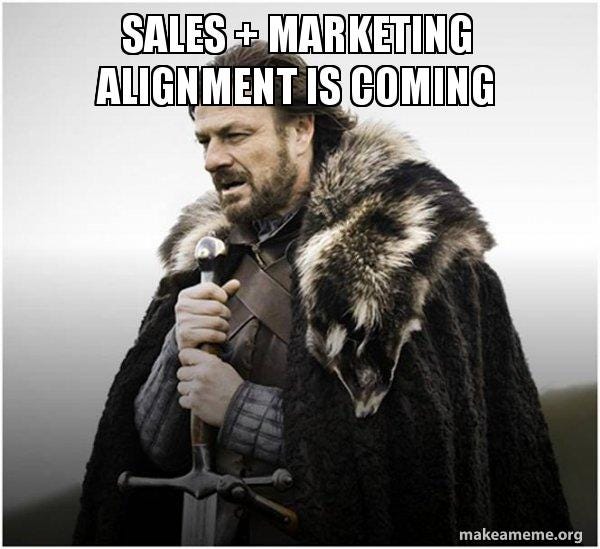
It is a proven fact that a company performs best in terms of revenue growth when Sales and Marketing work completely aligned 🤝 In a way, it’s like designing a hybrid car with a petrol engine and an electric one, both working in sync to provide a greater power. Most sales and marketing directors think this is easier said than done, but here’s the thing that successful growth companies do differently: their sales & marketing departments work on the same end goal and the same strategy 🌱
All it takes for Sales and Marketing to work together is to create one single growth strategy. In practical terms, this means creating the same plan, with the same goal, in the same document, used by both teams 🙌
After all, every aspect of the strategy is the same for sales and marketing: end goal, buyer journey, personas, value proposition, funnel stages, touchpoints, service blueprints, conversion rates, etc. The only thing that might differ from one team to another are: 1) the internal processes; and 2) the intermediate KPIs to reach the end goal.
Here’s the skeleton of the sales & marketing template we’ll follow:
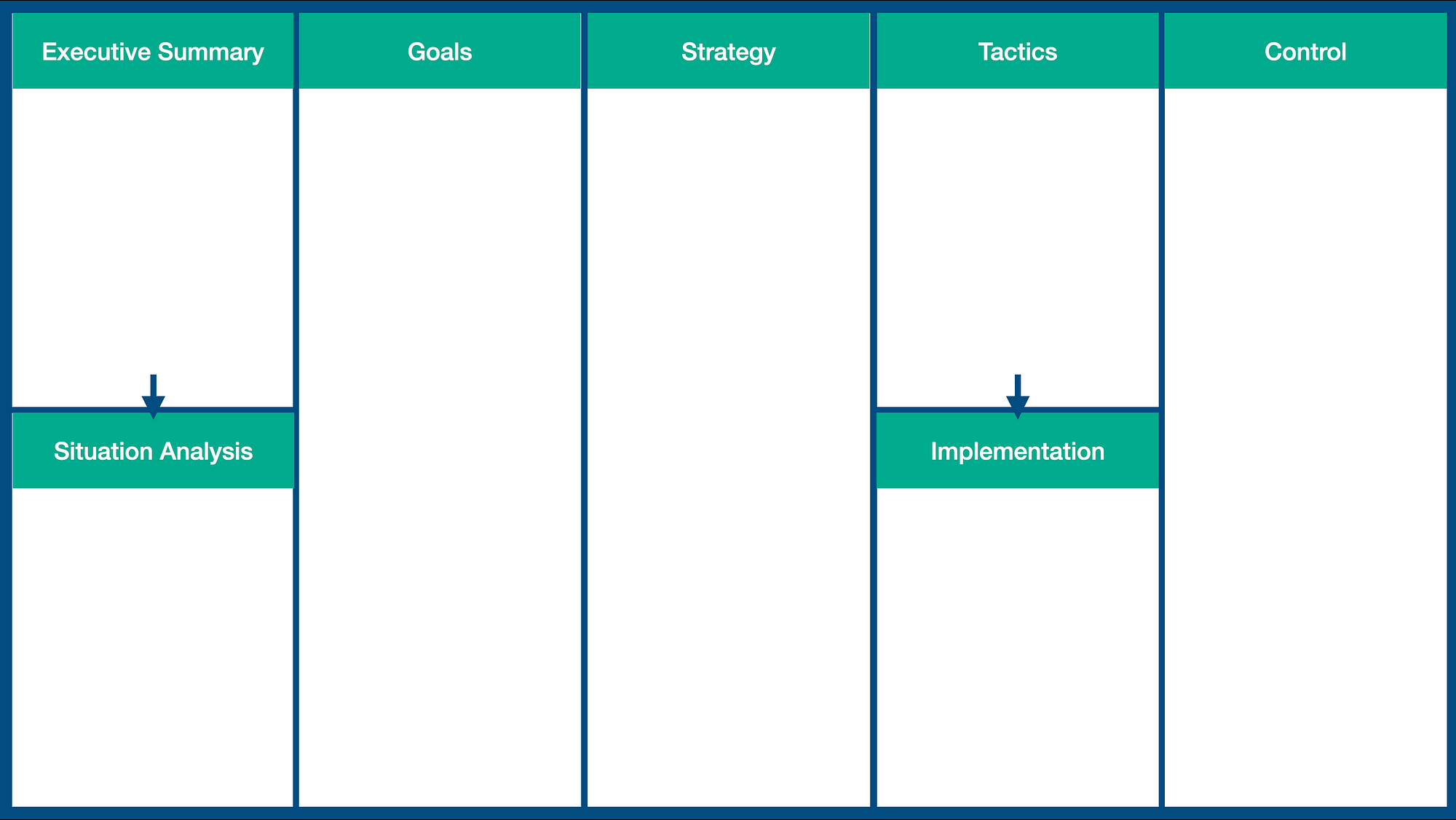
Before starting your strategy document, you’ll also need to choose a proven strategic framework to ensure you’re doing the right decisions. A strategic framework is a visual representation or logical flow of how strategic thinking should be implemented, including a guideline for adjustments in case things are not working appropriately. Below (Figure 1) you can find the four most popular strategic frameworks used in Sales & Marketing:
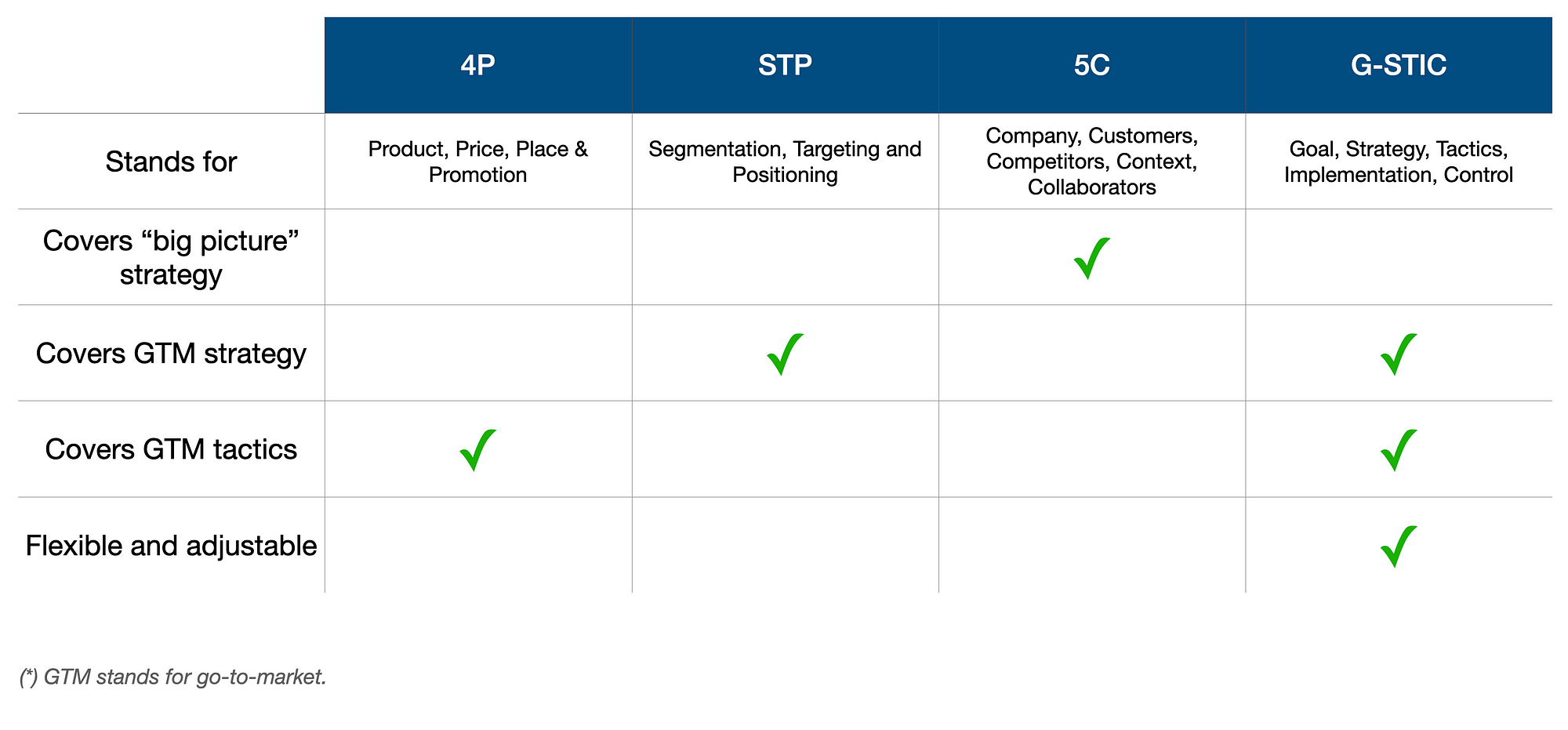
Based on my experience, I would recommend the G-STIC framework to small and medium-size companies, or those below 500 employees and less than $100 million in revenue 🏢 G-STIC provides a very solid approach to strategy while having a good level of flexibility and dynamism, so you can steer the ship in different directions almost on weekly basis 🚢
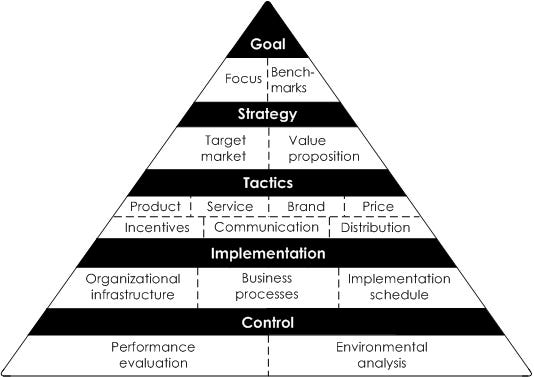
The greatest thing about G-STIC is that you can move linearly up and down the pyramid, if something goes wrong. For example, if your metrics look poor, you simply go one level up to Implementation and see if you did something wrong. If your Implementation looks good, then you can go up to the Tactics and see is there something wrong there. You can do the same process up to Strategy or, ultimately, you could even run into the original Goal (at the top of the pyramid) being too unrealistic. G-STIC is a top-down strategic approach that has consistently delivered great results in my entire career 🏆
Let’s jump onto the actual Sales & Marketing Strategy now 👇
1 Executive Summary
Here’s where your actual strategy document starts. The executive summary is the preamble for the marketing plan, which includes a description of the current market situation and the potential changes that will affect the business in the future.
After all, a strategy is just a plan to tackle two fundamental things:
- how to achieve an overarching goal
- a high-level proposed course of action to handle market changes and reduce negative impact
Example:
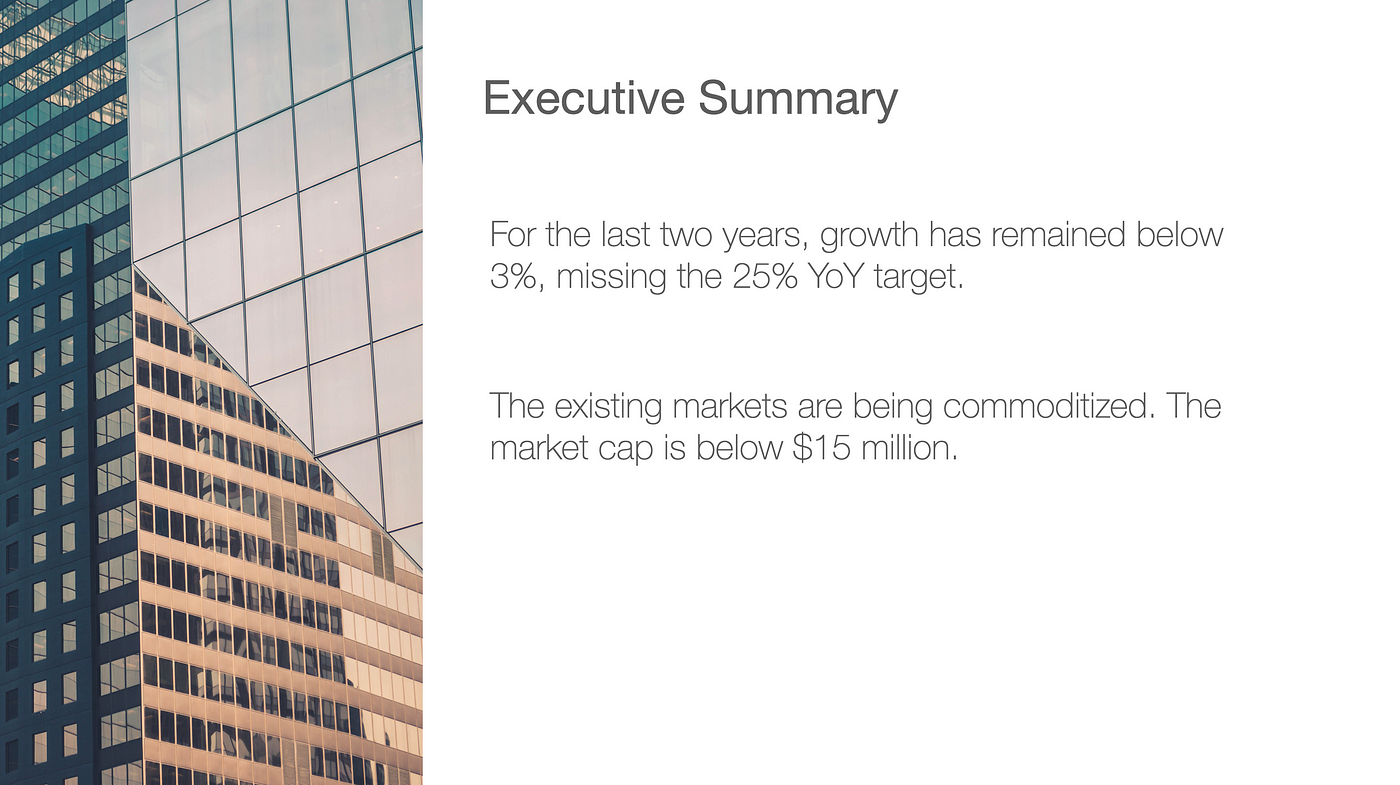
2 Situation Analysis
This section is a deep-dive into the Executive Summary, and aims to provide an overall evaluation of the company and the context in which it is operating, as well as identifying the markets in which it will compete 🥊
The purpose of the Situation Analysis section is to study whether the actual context and the frame of operations of the company allow for this plan to happen or not. Or, in plain words, what is the actual situation and all internal and external forces that can affect the company during the execution of this plan.
The Situation Analysis should include:
- the company overview: strategic goals, current processes, assets and offerings
- the market overview: characteristics of the market the company is targeting with this plan, including its size, needs (product-market fit) and competition landscape
💡Tip → it’s usually a good idea to use the SWOT Analysis tool or similar to map out the situation analysis for the company overview against the market characteristics.
Example of a Situation Analysis table of contents:

Once the executive summary and the situation analysis are documented, it’s time to jump to the real action: the G-STIC plan 🚀
3 Goals
The goals section is the most important one. It will be the foundation for the strategy and the details of the entire action plan. Here’s a representation of how to structure goal setting:
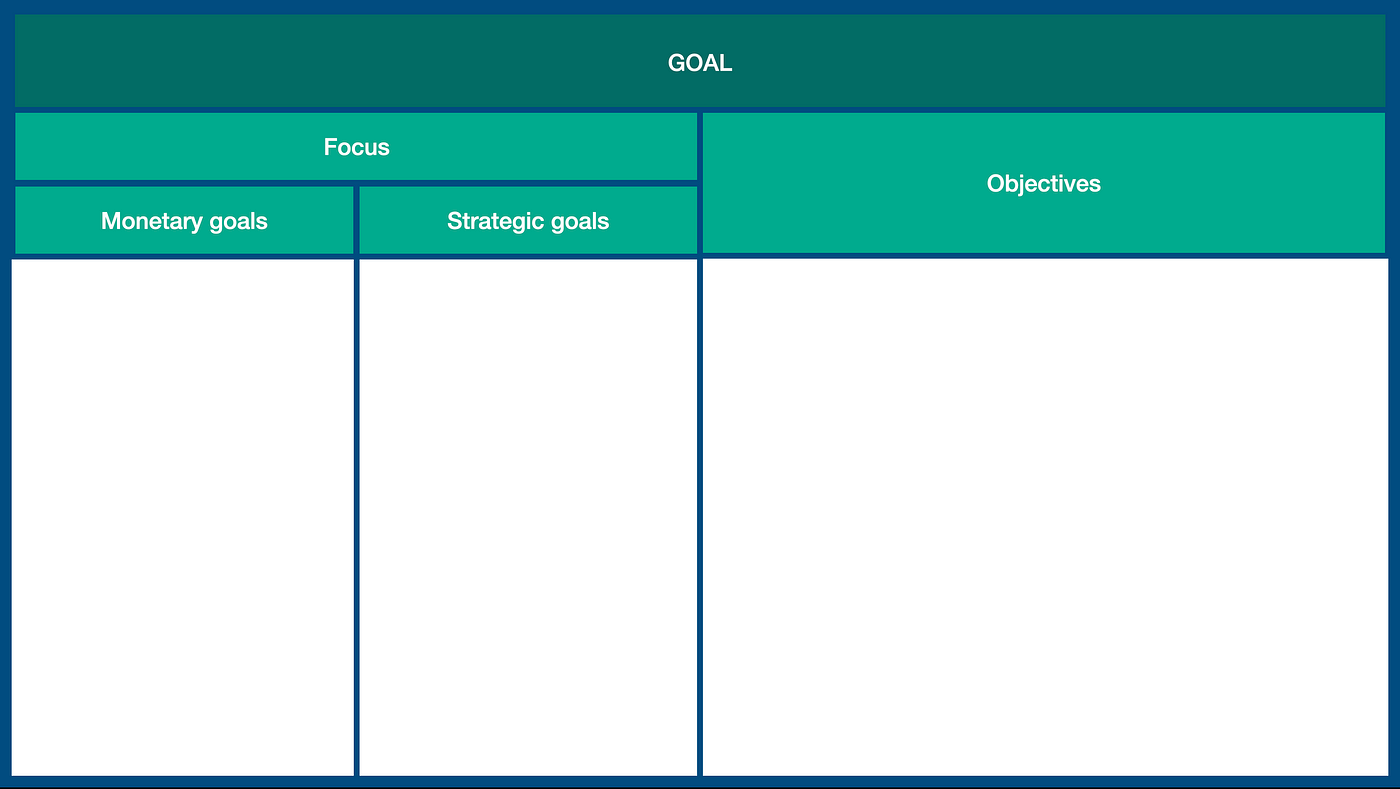
Figure 4 shows a simple way of structuring goals and objectives 👆, from the overarching ones (Focus) to the very details (Objectives), in just one page.
For the sake of clarity, it’s a common practice to split the Goals section into two parts: Focus and Objectives. Focus includes generic goals, both monetary and non-monetary (strategic) which are not necessarily measurable, but rather aspiring and inspiring 🦄 On the other hand, Objectives are specific benchmarks (target numbers), attached to a date when that target needs to be accomplished 📆
Monetary goals usually speak the revenue language (e.g., grow revenue by %, or reduce costs by %), whereas non-monetary (strategic) goals typically focus on brand positioning, competition, partners and/or internal operations.
Here’s an example 📊
- Monetary goals
- Increase annual net revenue by 30%
- Technical support costs down by 20%
2. Strategic (non-monetary) goals
- Steal 15% of the customer base from direct competitors
- Increase Enterprise sales
3. Objectives 👉 these should comprehend all “Focus” goals, monetary and non-monetary in a very specific and measurable way (target and date):
- Sell 2 million units in APAC by Q4 2022
- 10,000 less support calls globally by Q4 2022
- 1,700 new customers subscribed in competitor-attack campaigns by Q4 2022
- 200 new paying Enterprise accounts by Q4 2022
Goal setting and tracking is fundamental for a healthy growth organization 🚀 Setting clear objectives helps the company keep steering in the right direction, gives a frame of reference for managers to lead their teams aligned with business objectives, and makes everyone in the organization understand the direction in the course of action, as well as their mission, throughout the entire time.
There are many tools and frameworks to manage goal setting and tracking. Based on my experience, I recommend using the OKR (Objectives and Key Results) framework, introduced by Google and adopted by many scale companies around the globe. The OKR framework is both solid and agile enough, to make an entire organization run with a clear focus, without having to spend too much time on steering 🚢
4 Strategy
Once the goals are clear and sliced into concrete objectives, it’s time to document the actual strategy. The Strategy part of your document should include:
🌎 Target market(s)
The target markets are usually defined by geographic regions. Choosing a specific region or a limited number of regions is the first step to segment your target audience, and it will help you later when creating the Marketing Mix (i.e., your tactics). Lead generation campaigns, SEO, influencer marketing and basically anything you do will depend on the region, its language and its behavioral characteristics.
For instance, if your product or service only speaks English, it’s wiser to focus on those markets that can buy and use your product or service readily, like Australia, UK and the US. Therefore, your marketing strategy will have to understand how your buyers behave and make their purchasing decisions in those countries that you have selected.
🎯 ICPs
ICP stands for Ideal Customer Profile, and it is the next level of granularity in your marketing strategy. Once you have chosen the target market, you have to define who are your ideal buyers.
Beware that ICPs and Buyer Personas are the same thing in B2C. Therefore, when we are operating in B2C, we jump directly to buyer personas. Whereas, when we operate in B2B, we have to to first define ICPs (companies) and then Buyer Personas (the profiles of people who can influence the purchase within the ICP).
An ICP should describe the profile of company which needs your product or service the most, and it can be defined in many different ways. But, at a bare minimum, you should describe your ICP with the following properties:
- industry in which it operates (e.g., banking, IT consulting, HR)
- size of the organization (startup, SMB or corporation)
- circumstance which makes it an ideal buyer (e.g., “automating recruitment processes”)
Here’s an example: “we offer XXX to small and medium banks in the UK, that are looking into automating their recruitment process”
- Target market: United Kingdom
- Industry: banking
- Size: SMB
- Circumstance: need to automate their recruitment process
🕵️♀️ Buyer personas
Buyer personas go one level down within the ICP, describing all the people profiles within that organization who can influence and make the final purchase decision.
Taken from Hubspot:
Buyer personas are semi-fictional representations of your ideal customers based on data and research. They help you focus your time on qualified prospects, guide product development to suit the needs of your target customers, and align all work across your organization (from marketing to sales to service).
To define your Buyer personas, make sure you have enough data to answer the following questions (for each persona):
- Background 👉 title, weight within the company
- Demographics 👉 age, gender, income, lifestyle
- Identifiers 👉 anything that describes their way of thinking and acting — e.g., impulsive, data-driven, etc
- Goals 👉 how is this person measured within their organization (e.g., keep employees happy)
- Challenges 👉 what are their biggest concerns and fears (e.g., getting the wrong hires)
- What can you do? 👉 [INSERT HERE VALUE PROPOSITION]
There’s plenty of Science and studies that back Buyer Personas work. I strongly recommend you get started by reading Hubspot’s article on how to create and use Buyer Personas 👌
📦 Value proposition
Your Value proposition is what you offer to your customer to suffocate their problem 🧯 A fully documented Value proposition includes the list of all benefits and characteristics of your product or service, which will help your Buyer personas achieve their goals, and overcome their challenges.
A straightforward way of articulating value propositions is to describe your entire offering in one sentence in a way that it tackles the buyer personas’ challenges directly, and helps them achieve their top goals faster and easier. Here’s a typical formula for articulating a value proposition statement in just one sentence👇
We provide a [INSERT PRODUCT OR SERVICE] for [ICP] to [EFFECT] [CHALLENGE] and (achieve) [GOAL].
For example:
“We provide an AI recruitment management system for small and medium banks, to improve the accuracy of top roles hiring and increase eNPS much faster.”
Once you have a simple sentence describing your value proposition, it is also a good idea to create a list with all the benefits your offering can provide to your ICPs. An example of a complete Value proposition list to the sample statement above could be: higher accuracy through AI, automatic future updates, learns over time, easy to install, runs on any platform, etc.
🤩 Positioning
Strategic positioning defines the (fewer) characteristics of your product or service that set it apart from the competition. In other words, your positioning tells what is very unique and special from your value proposition, that nobody else can offer. This is also sometimes referred to as Unique Selling Points (USP).
Here’s a continuation of our example of a recruitment system for banks. In this example, the strategic positioning is “the first system in the world able to evolve” 👇
“We provide the world’s only Adaptive ML recruitment algorithm, capable of evolving based on actual employee turnover data.”
Please note that your strategic positioning will evolve over time based on the market landscape and your competitors’ response to your offering. As competitors catch up, you’ll have to find new USPs about your offering that set you apart, in order to stay ahead of the competition 🦄
Pro Tip 👉 A systematic way of refreshing your strategic positioning is to constantly look at the competitor landscape (i.e., quarterly basis), map out their value propositions and positioning statements, and try to find empty areas/untapped challenges that your competition hasn’t solved yet. By finding an area or challenge where nobody clearly wins, except your company, you can get a new competitive advantage and define a new strategic positioning for your offering.
Remember ☝️ Every time you update your strategic positioning, it requires a strategic communications campaign to inform the entire market, and especially your prospects and customers, about your new USP.
🛍 Brand
Last but not least, a proper Marketing Strategy should cover how the brand is going to support the rest of elements in the overall plan. The importance of the brand comes from the fact that purchase decisions are 80% emotional and 20% rational. Therefore, a brand can make a huge difference in customers’ buying decisions, plus it’s the most sophisticated tool for positioning yourself among competitors in a globally commoditized market 🏭
Your brand is the image that is projected on your customers’ mind about your offering, even when you don’t deliberately work on your branding efforts. Every customer forms an image of what your company and offering are, which helps them decide whether to buy or not, and at what “price” are they willing to buy. Therefore, strategic branding can be used to influence that image projected on customers’ mind, to alter the buying process, and make it much easier for you to sell 👇
Brand is a marketing tool used to identify an offering, differentiate it from similar market offerings, and create distinct market value above and beyond that created by the other marketing tactics.
Especially today, in a world of commoditization, brands are the only way to ensure superior value delivery to customers beyond the value proposition. Especially in consumer good markets, products always enter a phase of maturity where the customers are unable to see substantial differences between one offering and the other. Price and feature differences become also minor, leaving room for only one thing to set them apart: branding.
By including Brand in your Marketing Strategy, you want to ensure you portray the precise image you want in your customers’ mind 🧠 in order to boost the sales by accelerating the purchasing decision. Strategic brand management requires three overarching activities:
- Brand design 🎨→ carefully craft the identity and meaning of your brand associated with your offerings, that needs to be implanted in the customers’ minds.
- Brand communications 📢→ how the brand design is related to customers needs and continuously deliver that brand design to the customers in ways they understand, to keep (and refresh) that image in their mind.
- Sub-brand strategy ⬇️ → only in the case you have multiple brands/companies to manage, you’ll have to choose between one of the main branding strategies: master brand (one brand for all), free-standing brands (each brand runs independently) or endorser brands (e.g., 7Up by Pepsico).
To sum up, the “Strategy” part of every proper Marketing plan should include at least these six things 👇
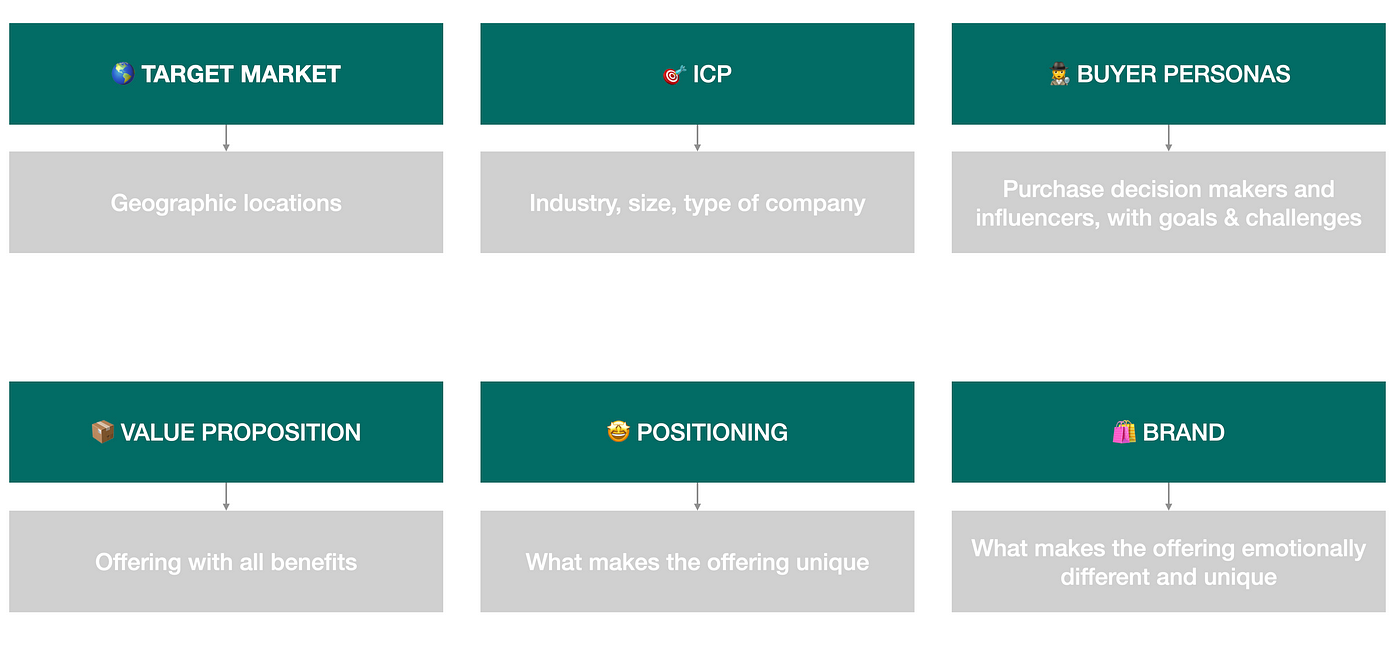
5 Tactics
In the “Tactics” section, it’s important to describe what kind of marketing activities will be carried out during the execution of the Marketing plan. Tactics are the actual marketing campaigns and projects that will go into execution or, in other words, the actual implementation of the Marketing strategy.
There is a vast number of different marketing tactics where to choose from, in order to make your strategy successful. From inbound sales & marketing to social media communications, going through all sorts of tactics such as Search Engine Optimization (SEO), App Search Optimization (ASO), Search Engine Marketing (SEM), event marketing, sponsorships, affiliate programs, influencer marketing, co-branding, lead generation campaigns; and a list that could go on forever. Here’s a good list of the 75 most common tactics used in Marketing these days 🔗
However, there are four important things I want your Sales and Marketing teams to walk away with after reading this article:
- Integrated Marketing Design & Communications (IMDC) 👉 based on my experience advising growth companies, I find the sweet-spot is to put Design & Communications all under the Marketing department, under the same Marketing strategy
- Data-driven orchestrated inbound & outbound sales efforts 👉 your CMO and Head of Sales should be obsessed with collecting, analyzing and exploiting all the data you can from your customers and their behavior. Using a systematic approach, you can leverage your customers’ data and create powerful parallel strategies for inbound (marketing) and outbound (sales), to reach out to customers in a way they won’t be able to refuse
- Pick your fights 👉 there’re way too many different things you can do in Marketing, so make sure you choose the ones that work best for your company and your target customers. The mantra is: customers don’t like to be sold, they like to buy. So find the channels where they love to hang out, understand what makes them initiate a purchase, and then place yourself in front of them at the right time, in the right place, using a perfect selection of tactics 🦚
- Comms for branding and positioning 👉 there’s too much noise in this world. So, whenever you communicate something (on your blog, social media, PR, event or any other campaign), make sure you focus on articulating the differences, the uniqueness and why you are the special provider and rest are the average ones. Set yourself apart with every communication you do, the race for distinction is a fierce one in today’s market.
Once you understand the importance of these four points, you’re all set to go and pick the selection of tactics you are going to run to make your marketing plan come a reality, and achieve your goals. Also, remember that the selection of tactics should be based on your chosen strategy and help you get to your objectives.
The last important piece about tactics is whether you can afford them or not. Marketing campaigns can cost zero (guerrilla marketing) or they can cost you millions per hour (prime location advertisement). Therefore, you should pick your tactics based on your budget and the resources you have, which is the next section in your Sales & Marketing Strategy document 👇
6 Implementation
As the really good saying goes: “Any vision without execution is just daydreaming” — And this is what makes the difference in a great CMO: the execution plan 🚀
The Implementation part of the plan should open up on the resources and how they are going to be used to take your strategy forward. There are three top things to document here:
- People 👩💼 → your greatest asset: who are they and what is going to be their role within your master plan. You should also include any subcontractors (e.g., marketing agencies) who are going to assist the in-house team in executing your marketing plan.
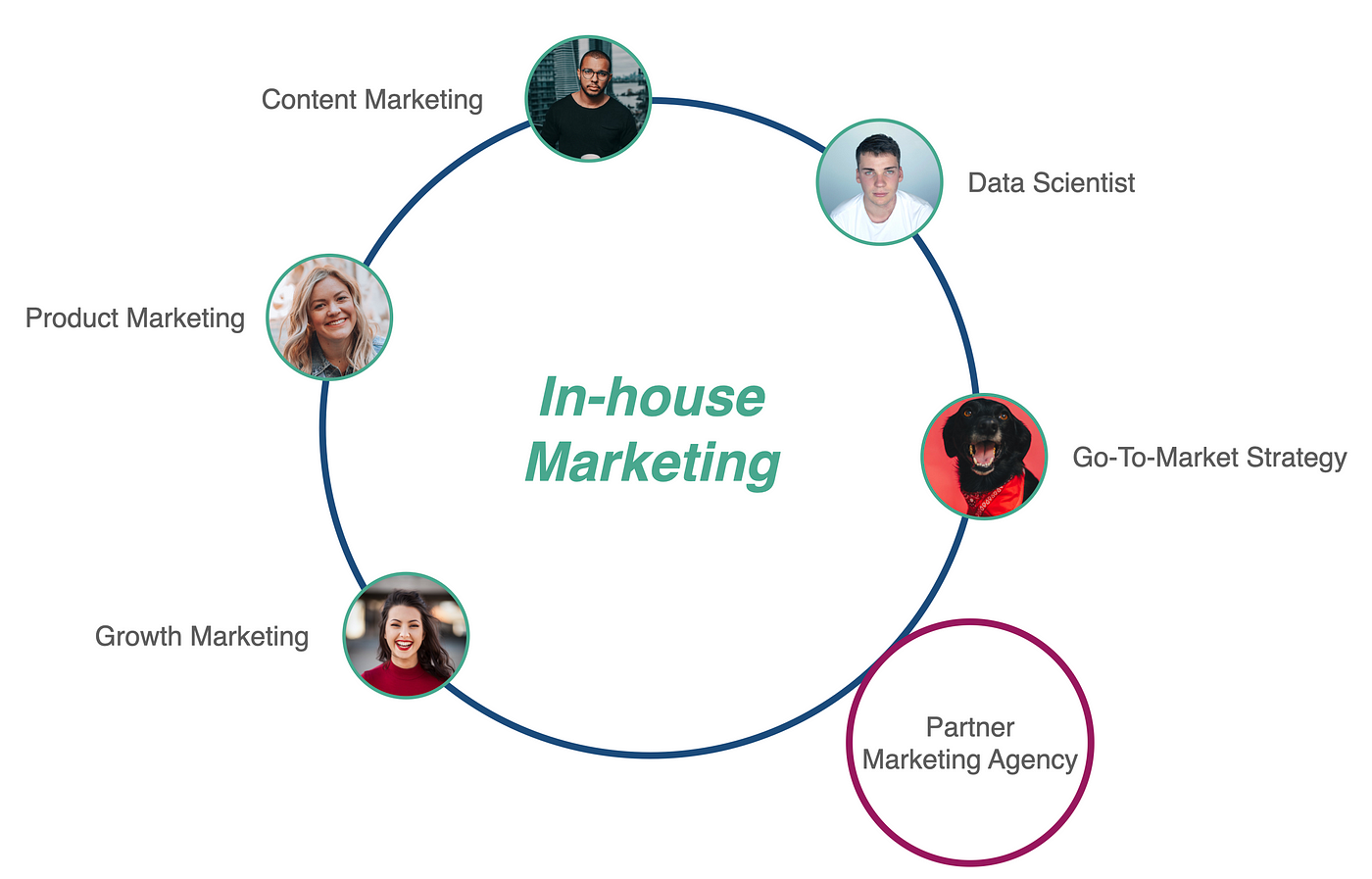
- Time ⏳ → what are the milestones and the timeline for achieving intermediate goals. In other words, your plan’s roadmap.
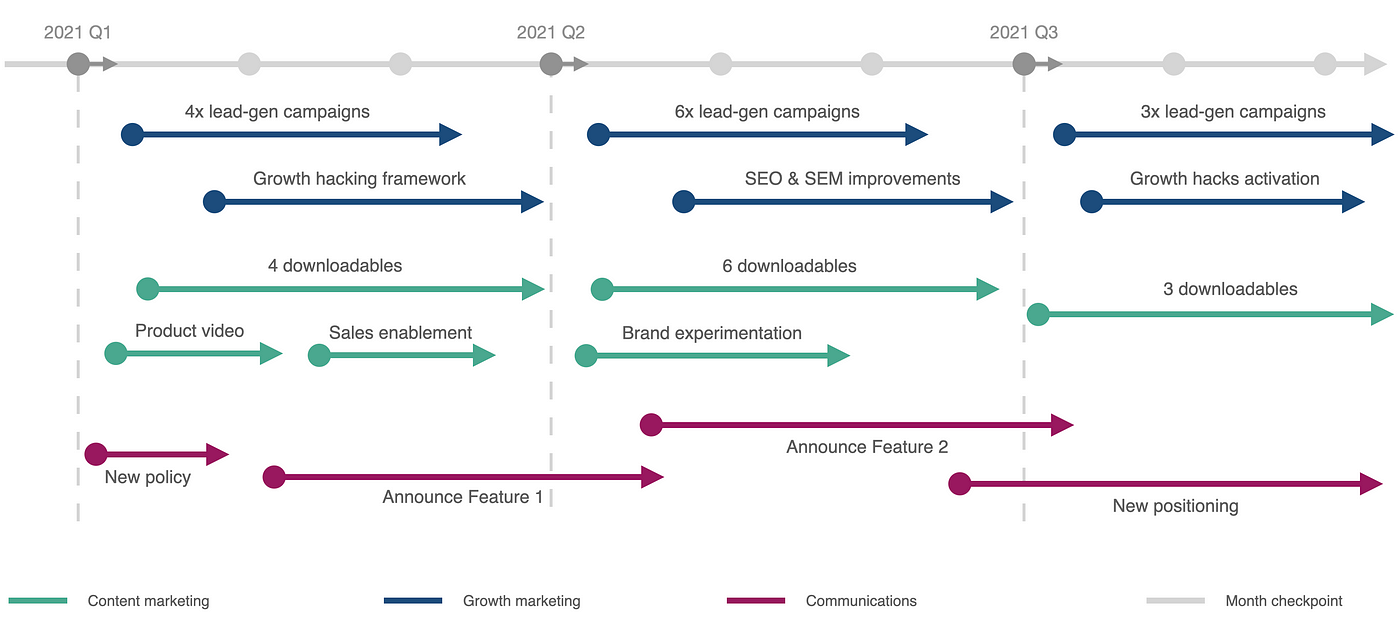
- Money 💰 → your budget structure and how it is going to be allocated across different dimensions: functions, time, business areas, etc.
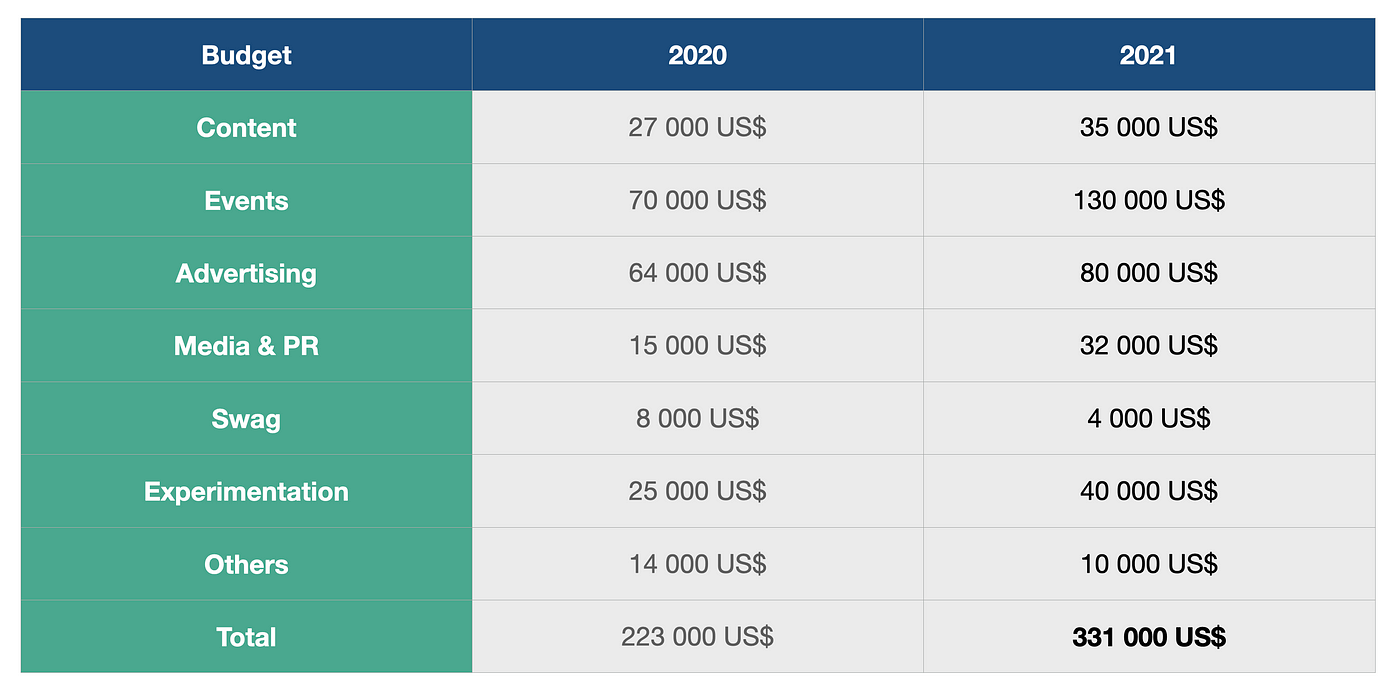
ROI Alert 🚨 Remember to use your Return On Marketing Investment (ROMI) to calculate the budget increase for the following year. For example, if your ROMI in 2020 was 2x and your budget was US$ 223k, you have brought US$ 700k in revenue through Marketing. So, if you’re given the goal to bring 990k in 2021 (knowing that your ROMI is 2x), you’ll need a budget of US$ 331k.
☝️ The Implementation part of your Sales & Marketing Strategy will back you when justifying your cost structure, key new hires or the time necessary to achieve certain goals. Make sure is well documented and justified.
7 Control
Now that you’ve built a solid plan for your Sales & Marketing team(s) to go forward with, it’s time to build a measure and control framework. A Control framework will enable you to track progress and success, as well as being able to detect any flaws in the plan along the way, and be able to fix them on the go 🔧 As someone on the Internet said 💭
If you can’t measure it, you can’t improve it.
A Control framework allows you to evaluate the progress towards your goals. Therefore, such framework has to be designed, aligned and executed completely in line with the original goals set in the Goal section at the beginning of your plan, following the G-STIC structure 👇
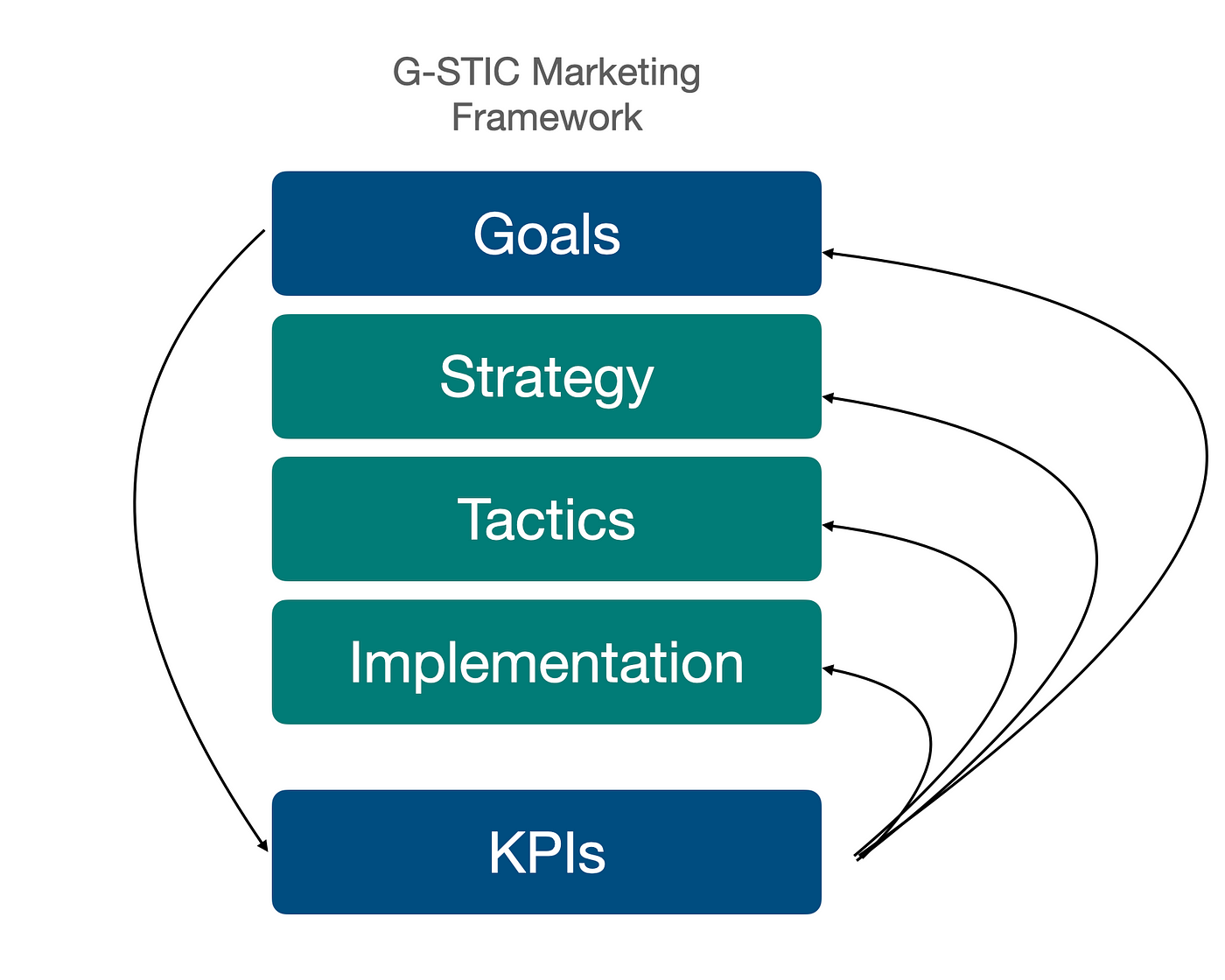
When designing your Control metrics, or Key Performance Indicators (KPI), you should start from your Goal, and drill down into the objectives. In practice, every objective (which is defined by a number and a deadline) should be translated into one measurable KPI and placed onto your KPI tracking framework to measure progress and performance 📈
When your Control framework tells you that there’s no progress, something must be wrong. The great thing about the G-STIC strategic framework is that you can always go back one step and review what you’re doing. For instance, if you’re not meeting the targets that you set at the beginning of the quarter, this is what you would do:
- If your metrics are not meeting the target, go up 🔼 one step in the G-STIC, that is, to the Implementation part. Something you are doing must be wrong.
- If your Implementation is fine and you’re resourcing all well, but still your metrics are not following, there must be something wrong with the chosen tactics. In other words, go up again one level and check your selected Tactics.
- If your Tactics are the correct ones, then you keep going up one level and check your overall strategy (target market, ICPs, buyer personas, etc). In the worst case, your goal must have been too ambitious, and you’ll need to settle with a more attainable goal 📉
There are many different sub-frameworks for progress measurement. The one I’ve used over the years and which I recommend to every mid-size growth company is the Objectives and Key Results (OKR) framework. OKRs map every goal into a so-called Objective (O1, O2, …), and group every outcome tied to that objective under so-called Key Results (kr1, kr2, …). Key Results are the actual performance indicators, in measurable numeric progress, that allow you to track your progress towards completion of that goal 📈
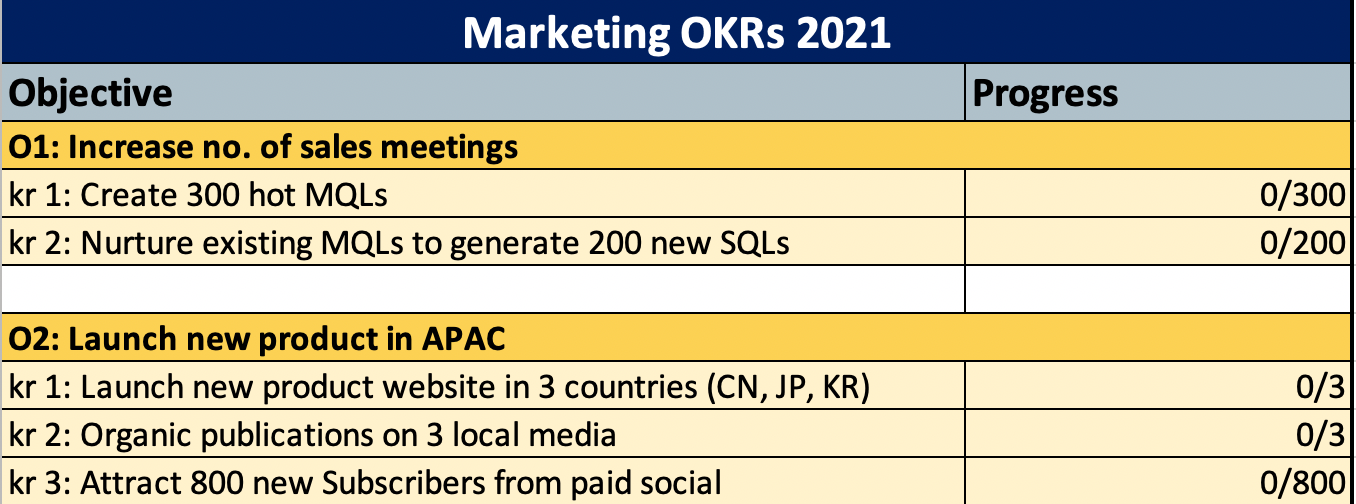
Heads-up! 👉 I’ll be writing a whole article about OKRs and how to use them to grow both teams and businesses. Stay tuned 📻
Once you have your goals, objectives and performance indicators mapped within your KPI framework (e.g., OKRs), there are two important things left to be done:
- Set up tracking meetings to check the progress with your team (either weekly, monthly or quarterly). Always focus on the ones that don’t progress and try to steer your daily activities on fixing those ones 💪
- Leave all vanity metrics (yes, the ones you get from your marketing tech stack and tools) to every function manager → content metrics for the Content Lead, Ads performance for the Advertising Lead, etc. You, as a CMO or CGO, should focus on the KPIs that contribute to the overall goals.
Summary
- When it comes to designing and implementing a Marketing strategy, remember to build it together with Sales from day 1. In other words, always build one unified Sales & Marketing Strategy, in one single document.
- G-STIC is a very powerful framework that will help you align Sales and Marketing together, and with the rest of the organization. Always start defining the goal, then agree on who to target and how, list the resources you need, and set up a way to track progress and steer.
- Your Sales & Marketing Strategy should clearly contribute to the overall business goals, and get approved by the CEO and, ultimately, by the board of directors.
- I can’t stress enough how important are the Goal and the Control parts of your G-STIC. Having realistic and ambitious goals with a systematic control framework in place will get you really far. All in between goals and control is then much easier to adjust, improve or change.

